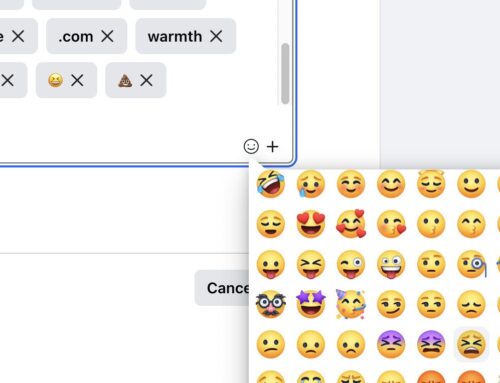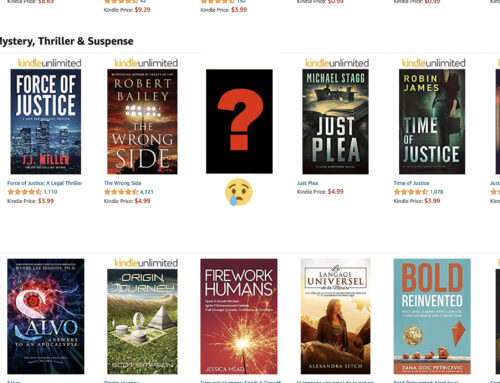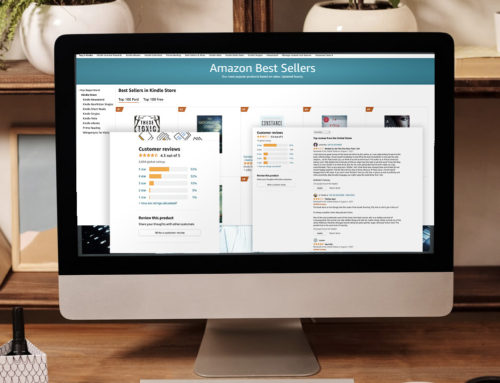
There are nearly infinite social networking sites in cyberspace meant for authors to promote themselves and their work. General sites would include Twitter, Facebook, and MySpace. Author Specific sites would include: Author’s Den, Red Room, Nothing Binding, and BookBuzzr. In addition, there is the marketing power of Amazon itself, where you can have an author page and blog as well as participate in many forums on the site itself.
One thing I’ve been personally guilty of is signing up for things like this as if that’s a mark of marketing productivity in and of itself. It isn’t. While it is true that the more places you can be found the better, and it’s true you will always have a trickle of people who stumble upon you and your work (especially if you use really good keywords and lots of description so people who search can find you)… still… the big power of social networking sites is using them.
This is where it gets tricky. You can spend an infinite time using all these various social platforms to socialize with people and get word about your book out there. And if you do spend infinite time doing this, you won’t get anything else done.
I’m not sure exactly where the purchase point is for people, but the general idea behind social networking for authors isn’t to spam people with your book title. Really all people need to know is that you are a writer, and the genre you write in. Which can be obliquely referred to or spelled out on a profile. If someone likes “you” enough, they will seek out what it is you write. If they don’t like you, then it’s pointless to tell them what you wrote, because social networking is all about personal likeability.
That’s why it’s called SOCIAL networking. You hope that you say something funny enough or charming enough or whatever to start a dialogue, and that that dialogue fosters a sort of casual online friendship that may result ultimately in a reader gained. You hope this reader gained, because of the social networking exposure and your availability to them, becomes a true fan. A true fan will buy everything you write, and not only will they buy everything you write, but they will talk about your work, blog about it, tell their friends about it. They are what makes the word-of-mouth machine run.
There is a common idea of 1,000 true fans, that you need this many fans to be able to make a living as an artist, be it a musician or a writer, or whatever. Keep in mind that 1,000 true fans doesn’t mean only 1,000 people will buy your work. It means you want to cultivate 1,000 rabid screaming tell everybody they know and buy everything you create, fans. If you have 1,000 of those fans, I believe you truly are set. Because those types of fans get the word out. Their enthusiasm for your work also is contagious.
While I agree with the math of 1,000 true fans, it’s almost impossible to measure such a thing. 1,000 twitter followers or facebook followers or even newsletter subscribers are not the same. I’m subscribed to some writers’ newsletters where I don’t buy everything they write. I don’t tell everybody and their brother’s cousin about it. I’m not a true fan, but I’m subscribed to their newsletter.
The 1,000 true fans concept may always only be a symbol of a truth, rather than something that can be literally measured. Meanwhile we’ll set our twitter follower, facebook follower, and newsletter subscriber goals much higher than that and hope that somewhere in all of that we connect with enough people to gain that magical number of true fans.
Which brings me back to this whole social networking thing. There are the two extremes: 1. Just signing up for a bunch of stuff but not doing anything with it. 2. Spending every waking second social networking. I don’t believe either is that productive.
It’s also important to note that you can’t necessarily judge the effectiveness of social networking based on the number of followers you have, as 20,000 completely casual Twitter followers who won’t buy your stuff and won’t retweet your tweets are useless except to make you “look” more popular to others. One hundred followers who “love” you and retweet your most charming or important tweets are far more valuable than 20,000 people who don’t take action at all. Because when you are retweeted, everyone on their list sees you.
There also is the psychology of the retweet. Once people see that this is being retweeted, they are more likely to retweet themselves, multiplying the effect of your original post. Social networking is not a popularity contest, and the goal is not to get “the most followers” the goal is to get as many “valuable” followers as possible, i.e. people who want to hear what you’re saying and will take action to follow through and not only buy what you’re selling but tell others about it. Without that last part you could have a million casual followers and all it will do is inflate your ego.
So what’s the best way to deal with social networking for the best results? I’ve been throwing this idea around and here is what I have right now as far as a “plan of attack” for more effective social networking toward the end of helping you in your quest for true fans.
- Sign up for everything. While it’s not enough to just sign up, and you don’t want to spend every waking second on all these different sites, if it’s free to sign up, you may as well. Some people will find you this way, and one thing I’ve learned from releasing KEPT is that you want your book in as many venues as possible, because not everybody goes to the same places. My book does much better at some sites than others, but I don’t really know the quality of those numbers. If I’ve gotten even one true fan from a smaller site, it was worth the effort of listing there.
- Pick 3 sites that will get your primary focus. I can’t tell you how to pick your three sites (nor will I tell you you can’t just focus on one, or you can’t focus on 5. I’m trying to keep this simple to give people a starting point.) I wish I could analyze and say: “Okay this site is definitely worth your while and will draw to you a strong number of true fans if you work it, and this other site is trash.” But I can’t. Everybody is so different. Each person really has to figure out what works for them. But once you find 3 networking sites that seem promising, you’ll want to focus on consistently interacting in these three places and building relationships, hopefully with people who are likely to read your work.
- While it’s important to interact regularly, you can’t “only” interact. There is a law of diminishing returns with social networking. You get to a point where repeated contact doesn’t help you, or it actually starts to hurt you. i.e. You know you’ve seen this person on the social networking sites: they post so often and usually but not always in the most self-promoting and obnoxious ways. You automatically delete emails from them, and after awhile you just stop following them all together. In the world of social networking, less can be more, as long as it isn’t so “less” that people forget who you are.
It’s important to set a social networking limit. It’s easy to look at it as productive to your writing and use it as an excuse to procrastinate from other more pressing matters like writing and editing. Marketing is important, but you have to have something to market, and building a backlist is as important as building a strong core fan base.
Hopefully reading this has helped you to start to come up with a balanced way of viewing social networking and where it stands in the grand scheme of your marketing plan.
Get an Editorial Review | Get Amazon Sales & Reviews | Get Edited | Get Beta Readers | Enter the SPR Book Awards | Other Marketing Services






















Helpful. I’ve been wondering about how to balance the social networking, how much to participate, how to stop participating when I feel like I need to do something else, etc.
I’m so glad you wrote this.
Thanks, Kristen, I’m glad it was helpful to you!
Hi,
Nice article with plenty of actionable advice. Thanks also for the mention about BookBuzzr. We’re honored!
Warm Regards,
Vikram Narayan
BookBuzzr.com
Free, Online Book-Marketing Technology for Authors
Hi Vikram! Thanks for stopping by!
Nice thoughtful piece Zoe.
I’m currently promoting a newly (self-)published work and social networking is my means of doing so. However, there’s a fine balance to strike, as you say. Been flooding the tweetstream with stuff about the book over the past few days. While it brought a lot of interest at first, things seem to have died down a little now and I’m a bit concerned about overdoing it.
Although there’s probably a little more actual ‘interacting’ I can be doing, there’s also making sure that I don’t let the rest of my life slip by too!
Useful advice.
Hey Dom,
Thanks!
Yes, if the interest is dying down a little, back off and either explore other different social networking venues (hopefully places where you don’t have a lot of follower overlap), or just give it a rest for a few days and look for other ways to market/social network that includes less talk specifically about your book and more talk about things that are just interesting or interesting and peripherally related to your book but not mentioning your book.
The key is to get people going: “Hey this person is interesting, I like what they have to say.” If they like what you have to say, they’ll find your website (especially if you have the link available on all of your social networking platforms), then they can read all about your books to their heart’s content. The more they think finding your book was their idea and not your idea, the easier the sale is.
It also helps to have something free to give away. If you’re doing nonfiction, a booklet, or tips would be nice, to let the reader know that you know what you’re talking about and aren’t blowing smoke out your butt. And if it’s fiction a short story or novella or sample chapters of the book, to give them a taste of what you have to offer: your style, etc.
Hey Zoe,
That’s a fast response – thanks a lot! I’ve just realised that this is an old post of yours too, so glad to see that you keep an eye on what you put out there.
Really useful advice above. There are a few other networking platforms that I’ve not really explored enough yet, and which don’t really have a great deal of follower overlap, so I’ll give them a go too.
I kind of have some of the stuff available for free already. The book is a collection of photos and writings from a five-year period when I lived in Japan, and much of the content is already available on other sites (my writings blog, Flickr for the photos, etc). The main reason for the big push at the moment though is that I’ve entered it into a contest, which means I’m trying to pull together votes for it before the submission deadline expires.
Any experience with traditional media giving coverage to self-published works?